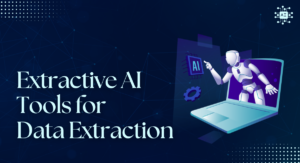AI data extraction tools have become essential for businesses managing large datasets and documents.
AI data extraction tools automate repetitive tasks, minimize errors, and accelerate processes, making data more accessible and actionable.
Whether dealing with customer records, financial documents, or large-scale data from various sources, AI-driven data extraction solutions offer distinct advantages.
This blog will explore the top AI data extraction tools in 2024, highlighting their key features, benefits, and how they can improve business operations. Additionally, we’ll examine why data extraction is crucial for modern businesses and the advantages of automating this critical process.
Best data extraction software powered by AI:
| Tool Name | Customizable AI Workflows | Real-time Data Extraction | Document Type Support | Integration with ERP/Cloud | Free Plan Availability |
| KlearStack | Yes | Yes | Unstructured | Yes | Custom |
| V7 Go | No | Yes | Images, Videos | Yes | Yes |
| Octoparse | No | No | Web Pages | No | Yes |
| Apify | Yes | Yes | Web Pages | Yes | Yes |
| Airbyte | No | Yes | APIs, Databases | Yes | Yes |
| Fivetran | Yes | Yes | APIs, Databases | Yes | No |
| Improvado | Yes | Yes | Marketing Data | Yes | No |
| Hevo Data | Yes | Yes | APIs, Databases | Yes | Yes |
| Import.io | No | No | Web Pages | No | No |
| Integrate.io | Yes | Yes | APIs, Databases | Yes | No |
| Microblink | No | Yes | IDs, Invoices | Yes | No |
| Mindee | No | Yes | Invoices, Receipts | Yes | Yes |
| Infrrd | Yes | Yes | Claims, Invoices | Yes | No |
| Bright Data | Yes | Yes | Web Pages | Yes | No |
| Docparser | Yes | No | PDFs, Scanned Docs | Yes | No |
| Nanonets | Yes | Yes | Invoices, Receipts | Yes | Yes |
| Parseur | Yes | No | Emails, Attachments | Yes | Yes |
| Rossum | Yes | Yes | Invoices, Receipts | Yes | No |
| Docsumo | Yes | Yes | Invoices, Contracts | Yes | No |
| Matillion | Yes | Yes | Cloud Data | Yes | No |
What is Data Extraction?
Data extraction refers to retrieving information from sources like documents, databases, websites, or PDFs.
Data extraction is equipped with optical character recognition (OCR), natural language processing (NLP), and AI, which automate this process, converting structured or unstructured data into an easily usable format for analysis and storage.
Key Features to Look for in Data Extraction Tools
When choosing a data extraction tool, it’s essential to consider features that align with your business needs:
- Accuracy: High-level accuracy in capturing and structuring data is crucial.
- Speed: Fast data extraction to support real-time analytics.
- Scalability: The ability to handle large datasets efficiently.
- Integration: Seamless integration with other business systems.
- Customization: Tools that offer customizable extraction workflows.
Why Do Companies Need Data Extraction?
Companies rely on data extraction tools to manage large volumes of information daily. Whether it’s invoices, customer data, or web scraping for market analysis, manual extraction is slow and error-prone.
Automating this process with advanced tools increases speed and accuracy while handling large data sets efficiently.
This allows businesses to focus on strategic decisions instead of administrative tasks.
Data extraction tools benefit companies by:
- Automating document processing and improving accuracy
- Reducing manual data entry errors
- Supporting real-time analytics for better decision-making
- Cutting costs by minimizing labor-intensive tasks
Top 20 AI Data Extraction Tools in 2024
1. KlearStack
KlearStack stands out as a top-tier intelligent document processing (IDP) solution for organizations that need to automate and optimize their data extraction processes. Particularly valuable for large enterprises in supply chain management, finance, and manufacturing.
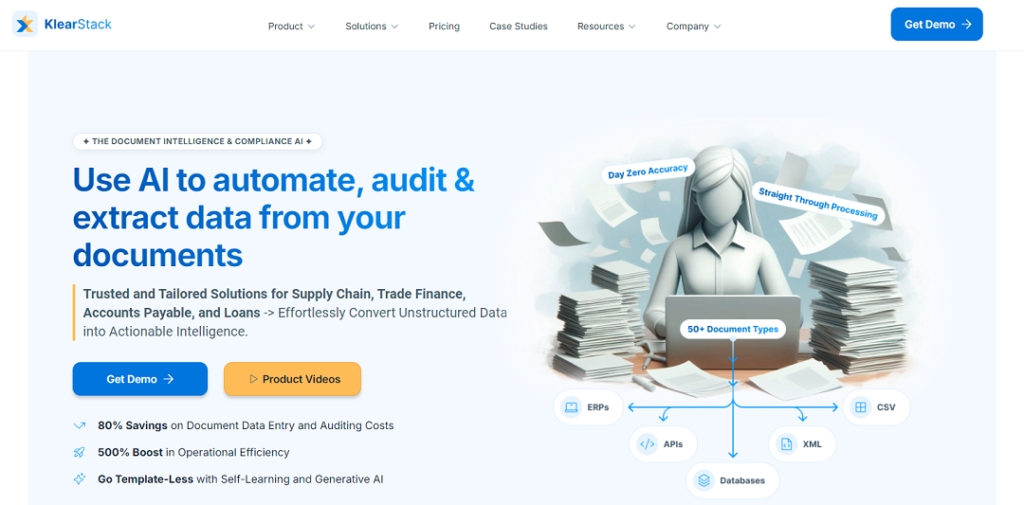
With advanced automotive and generative AI, KlearStack achieves over 99% accuracy in extracting data from a variety of formats, including PDFs, images, emails, and scanned documents. T
his high accuracy helps companies reduce operational costs by up to 80%. It is ideal for extracting data from invoices, ID cards, and bills of lading, making it a strong option for industries handling large amounts of transactional data.
KlearStack excels in enterprise environments by processing complex documents and integrating with ERP (Enterprise Resource Planning ), accounting, and RPA systems like SAP, QuickBooks, and Traze. It is not suited for personal use but offers reliability and flexibility for businesses. Users can leverage pre-trained models or create custom ones based on their unique requirements.
To increase reader engagement, include visual elements like comparison tables for industry-specific use cases or interactive infographics showcasing cost savings with automation.
| Key Features: | ➡️ Pre-trained document models and custom model creation ➡️ Supports document & page auto-classification and splitting ➡️ Easy-to-use APIs for seamless integration Template-free data extraction from various document formats ➡️ Data validation and reconciliation for accuracy Out-of-the-box integrations with SAP, QuickBooks, AWS, and Google Drive |
| Pricing | Standard: Designed for small to medium-sized businesses Premium: For larger businesses with advanced data extraction needs Enterprise: Tailored for large-scale organizations requiring extensive customization |
| Pros | 👉 99% Accuracy 👉 Suitable for invoices, Receipt, Us Passport, OMR sheet, Airway Bill, Purchase Order, India Passport, Transport Bill and other numbers of document types 👉 Reliable and Robust Solution 👉 Seamless integrations with any accounting, ERP or RPA systems. Out-of-the-box integrations with SAP, QuickBooks, Traze, AWS S3 Bucket, Google Drive, Secure FTP and other logistics ERPs |
| Cons | 👉 Not suitable for personal use. 👉 Trial version is not available |
2. V7 Go
V7 Go is a highly versatile AI-powered data extraction tool known for its ability to handle multiple formats, such as images, videos, and documents. It excels in industries like healthcare, automotive, and manufacturing, where complex data needs to be processed and labelled efficiently.
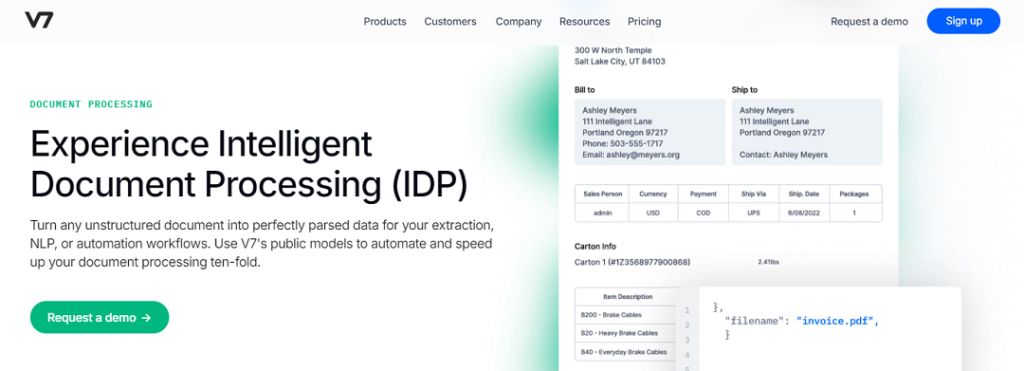
What sets V7 Go apart is its collaborative features, which allow teams to work together in real time, ensuring that large-scale projects are completed faster and with greater accuracy.
V7 Go simplifies the extraction process by integrating machine learning models that automate data labelling and extraction. This makes it ideal for businesses looking to streamline their workflows without the need for extensive manual intervention.
V7 Go is not just a powerful tool, it’s also designed for scalability. This makes it an invaluable resource for enterprises dealing with large datasets across different teams. Its scalability ensures that it can grow with your business, adapting to your changing data processing needs.
| Key Features: | ➡️ Multi-format support for images, videos, and documents ➡️ AI-powered annotation and labeling tools Collaboration-friendly, ideal for large teams ➡️ API integration with machine learning models Supports real-time data extraction and processing |
| Pricing | Basic: Try to Go for free, with 100K platform tokens Pro: $249/month, suited for larger teams and advanced projects Enterprise: Custom pricing for large-scale enterprise solutions |
3. Octoparse
Octoparse is a no-code web scraping tool designed for users who need to extract structured data from websites without writing any code. It’s perfect for businesses that want to automate their web scraping tasks for data analysis, reporting, or lead generation.
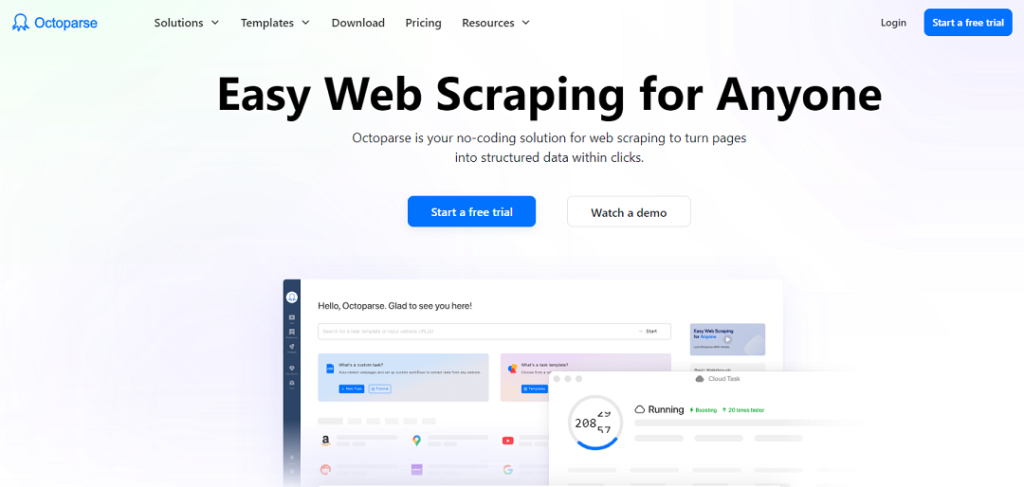
Octoparse supports cloud-based data scraping, allowing users to run tasks on a large scale without worrying about local hardware limitations. It also offers built-in IP rotation, which prevents websites from blocking the scraping process.
Scheduled scraping capabilities, Octoparse ensures businesses can automate regular data updates without manual intervention, making it a powerful tool for competitive research and market analysis.
| Key Features: | ➡️ No-code web scraping with a point-and-click interface ➡️ Cloud-based scraping for large-scale data extraction ➡️ IP rotation to avoid website blocking ➡️ Supports data scraping from both static and dynamic websites ➡️ Automated scheduling for regular data updates |
| Pricing | Free Plan: Limited features and lower scraping frequency Standard: $99/month for advanced scraping options and cloud storage Professional: $249/month with more robust scraping capabilities Enterprise: Custom pricing for large-scale, high-frequency scraping needs |
4. Apify
Apify is a powerful data extraction and web automation platform that allows developers to build and deploy custom scrapers. It is designed for users who require complex web scraping tasks to be automated efficiently.
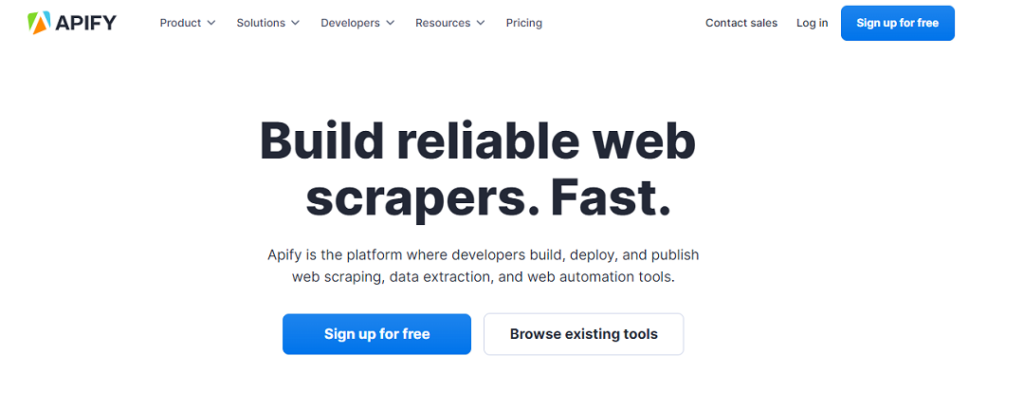
Apify supports a wide range of open-source libraries and APIs, providing users with flexibility in how they collect and manage their data.
Though it has a steeper learning curve compared to other tools, Apify is excellent for users needing large-scale web scraping, market research, or machine learning data preparation.
| Key Features: | ➡️ No-code web scraping with a point-and-click interface ➡️ Cloud-based scraping for large-scale data extraction ➡️ IP rotation to avoid website blocking ➡️ Supports data scraping from both static and dynamic websites ➡️ Automated scheduling for regular data updates |
| Pricing | Free and Business plan Custom pricing |
5. Airbyte
Airbyte is an open-source data integration platform that focuses on making data connectivity simple and accessible for organizations of all sizes.
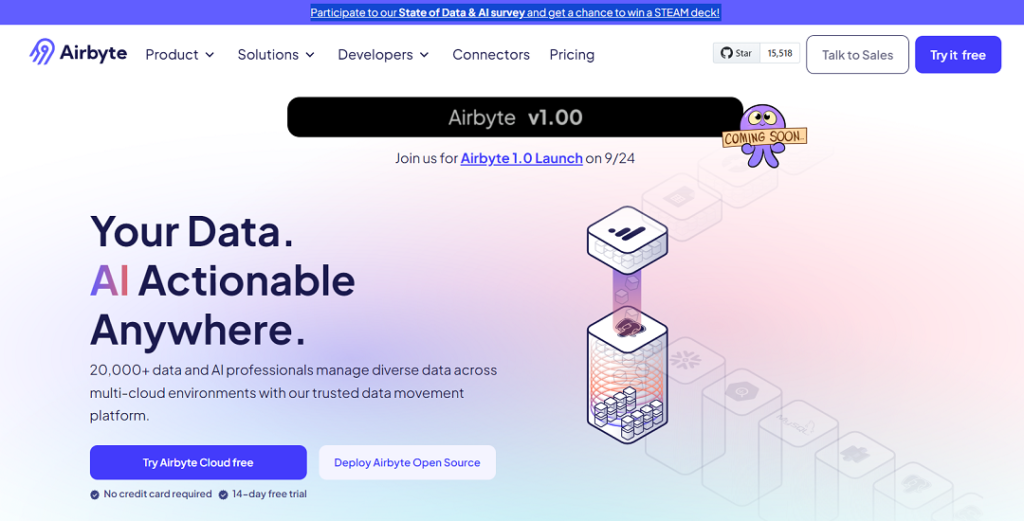
It enables teams to extract and load data from various sources into data warehouses, helping businesses maintain a single source of truth. Airbyte offers pre-built connectors for hundreds of platforms, making data extraction fast and seamless.
| Key Features: | ➡️ Open-source platform with extensive connector library ➡️ Seamless data extraction from various sources like APIs, databases, and cloud applications ➡️ Custom connector creation for specific data needsReal-time data sync capabilities ➡️ Scalability for businesses of any size |
| Pricing | Free Plan: Open-source, self-hosted Cloud Plan: Starts at $2.50/credit for usage-based pricing Enterprise Plan: Custom pricing with additional features and support |
6. Fivetran
Fivetran is a leading data pipeline tool that helps businesses extract, load, and transform data from numerous sources into a data warehouse.
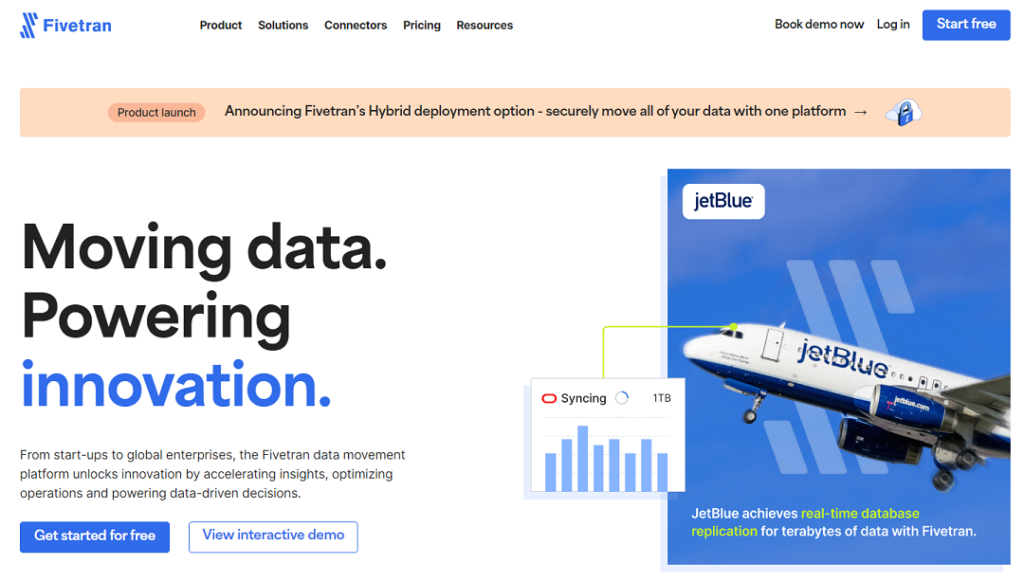
Its key strength lies in the automated data pipeline setup, which allows businesses to extract data without dealing with the complexities of coding or server management.
Fivetran focuses on maintaining data integrity, ensuring that teams can focus on analysis rather than data preparation.
| Key Features: | ➡️ Fully managed data pipelines for easy setupHundreds of pre-built connectors for diverse data sources ➡️ Automatic schema updates to maintain data integrity ➡️ Centralized data warehouse integration ➡️ Secure, encrypted data transfers |
| Pricing | Starter Plan: Access Standard Plan features Standard Plan: Credit for basic usage Enterprise Plan: Custom pricing |
7. Improvado
Improvado is designed specifically for marketing data extraction and integration.
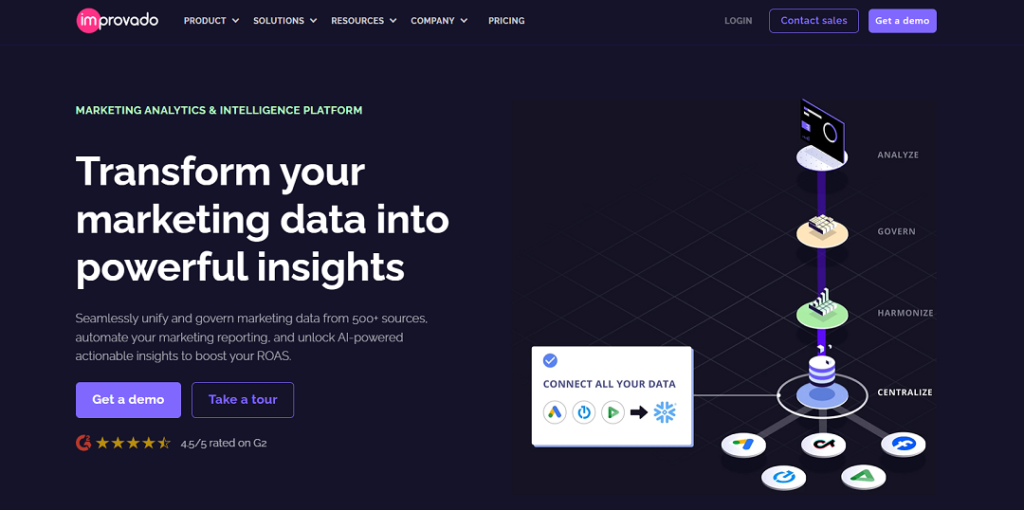
It allows businesses to collect data from various marketing platforms such as Google Ads, Facebook, and HubSpot and centralize it into one dashboard. Improvado eliminates the need for manual data aggregation, saving time and reducing errors in reporting.
| Key Features: | ➡️ Pre-built connectors for marketing data sources ➡️ Centralized marketing dashboards for better analysis ➡️ Real-time data extraction and integration ➡️ Custom reporting features for detailed insights ➡️ API access for advanced data manipulation |
| Pricing | Custom pricing |
8. Hevo Data
Hevo Data is a no-code data pipeline platform that helps organizations integrate and extract data from multiple sources into a single location.
It supports real-time data replication and provides automatic schema mapping, ensuring that the extracted data fits seamlessly into the destination warehouse.
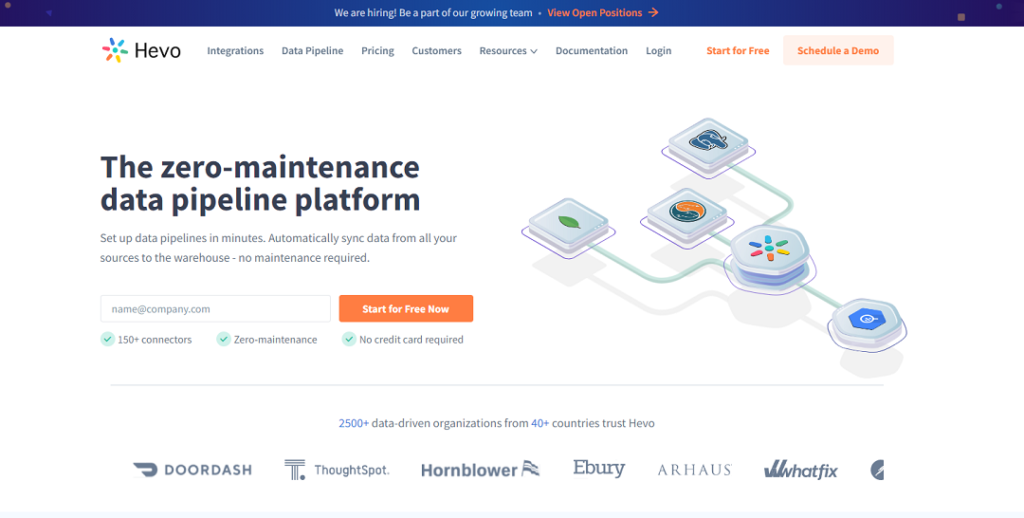
Hevo is ideal for teams that need quick, reliable data flow without extensive engineering resources.
| Key Features: | ➡️ No-code data pipeline setup with pre-built integrations ➡️ Real-time data replication for timely insights |
| Pricing | Free Plan: Limited to 1 million events per month Starter Plan: $249/month for 20 million events Business Plan: Custom pricing for higher volume |
9. Import.io
Import.io is another web data extraction tool known for its ability to convert web data into structured datasets without writing a single line of code.
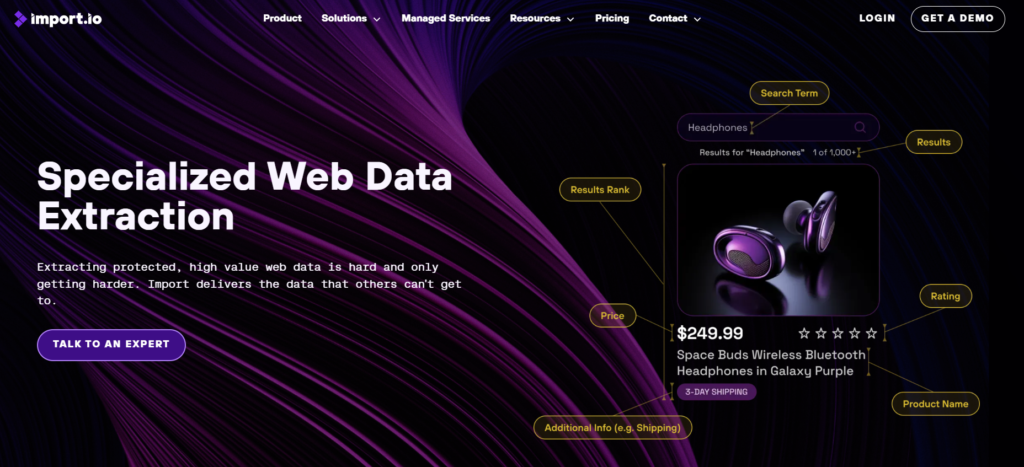
With its point-and-click interface, users can extract data from any website and export it into various formats for analysis.
| Key Features: | ➡️ Visual web data extraction without coding ➡️ Ability to scrape complex websites with dynamic content ➡️ Export data into formats such as CSV, Excel, or JSON ➡️ Scalable for both small and large scraping projects |
| Pricing | Starter Plan: $399/month Standard Plan: $599/month Enterprise Plan: Custom pricing based on needs |
10. Integrate.io
Integrate.io, formerly known as Xplenty, is a data integration tool that focuses on data extraction, transformation, and loading (ETL) processes.
It offers an easy-to-use interface, making it simple for users to create data pipelines without requiring deep technical knowledge.
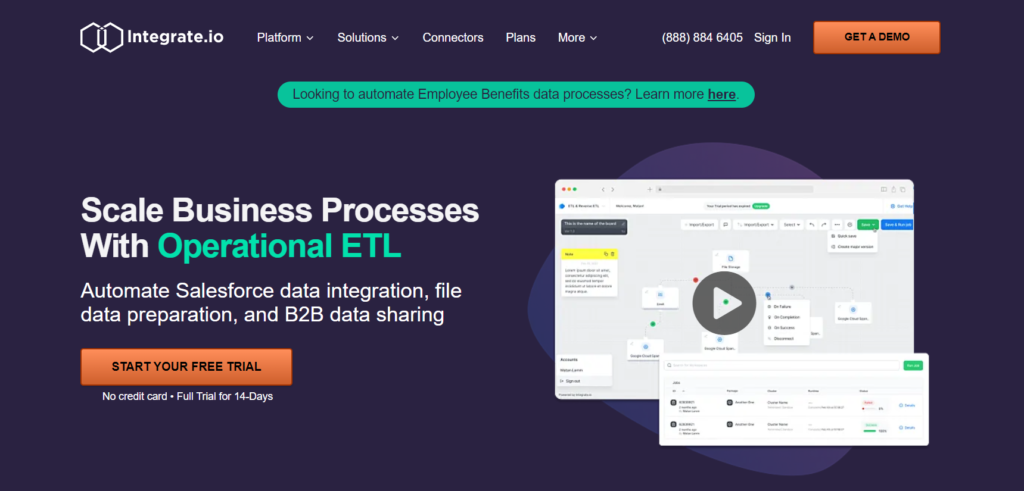
Integrate.io also supports various integrations with cloud platforms, databases, and SaaS applications, enabling businesses to centralize their data for analysis.
| Key Features: | ➡️ Simple, intuitive ETL platform for non-technical users ➡️ Pre-built connectors for various databases and cloud applications ➡️ Scalable for both small and large data projects ➡️ API access for custom integrations |
| Pricing | Custom pricing based on data volume and usage requirements |
11. Microblink
Microblink is a leader in AI-powered data extraction, particularly focusing on mobile solutions. It enables businesses to capture data from physical documents like IDs, passports, and invoices using mobile devices.
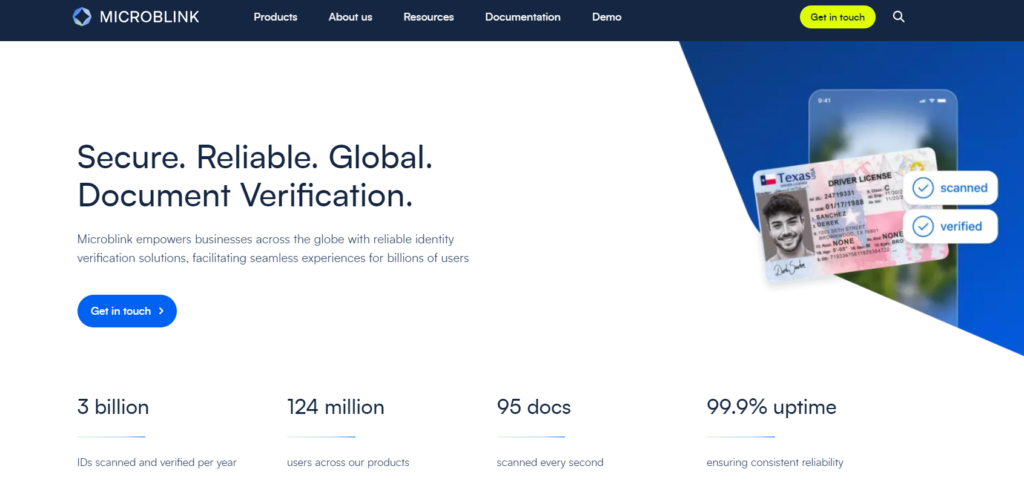
This makes it particularly useful in industries like banking, insurance, and retail, where fast, accurate data capture is essential. Its advanced AI models ensure accuracy, even with complex document structures.
| Key Features: | ➡️ Mobile-friendly ➡️ AI-based data extraction ➡️ Specialized solutions for ID, passport, and invoice processing ➡️ Real-time data capture with high accuracy ➡️ Customizable workflows for different industries ➡️ Secure processing with compliance features like GDPR |
| Pricing | Microblink’s pricing is customized based on industry, volume, and the type of document processing required. |
12. Mindee
Mindee specializes in document parsing, offering developers APIs to integrate optical character recognition (OCR) capabilities into their own applications.
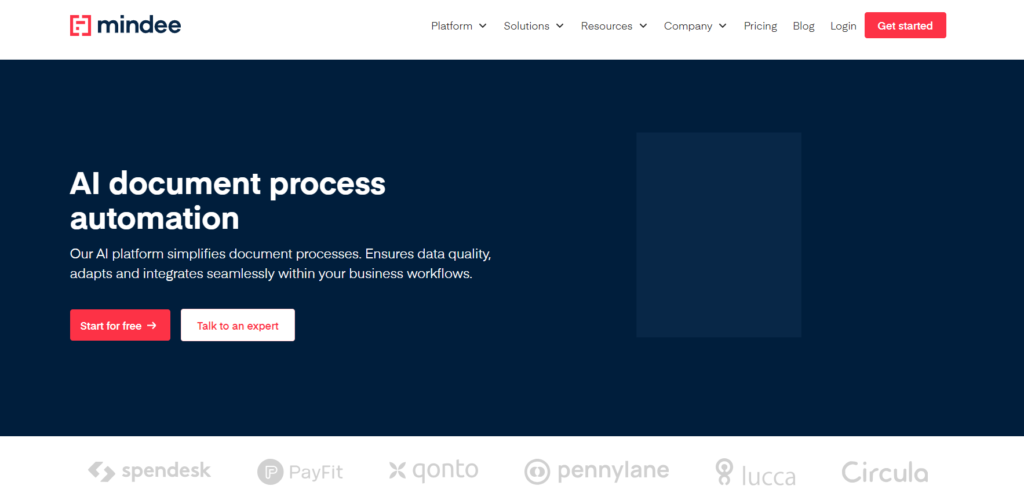
Mindee can process invoices, receipts, and other documents with high precision. Its API-centric approach makes it an excellent choice for businesses looking to add OCR features to existing systems without building from scratch.
| Key Features: | ➡️ API-based OCR for easy integration into existing platforms ➡️ High accuracy in extracting data from complex documents ➡️ Pre-trained models for invoices, receipts, and ID cards ➡️ Real-time document processing ➡️ Flexible pricing model based on usage |
| Pricing | Mindee pricing is customized based on industry, volume, and the type of document processing required. |
13. Infrrd
Infrrd is a data extraction platform known for its AI-driven approach to document processing. It’s particularly strong in industries like insurance, finance, and logistics, where it helps automate claims processing, invoice management, and customer onboarding.
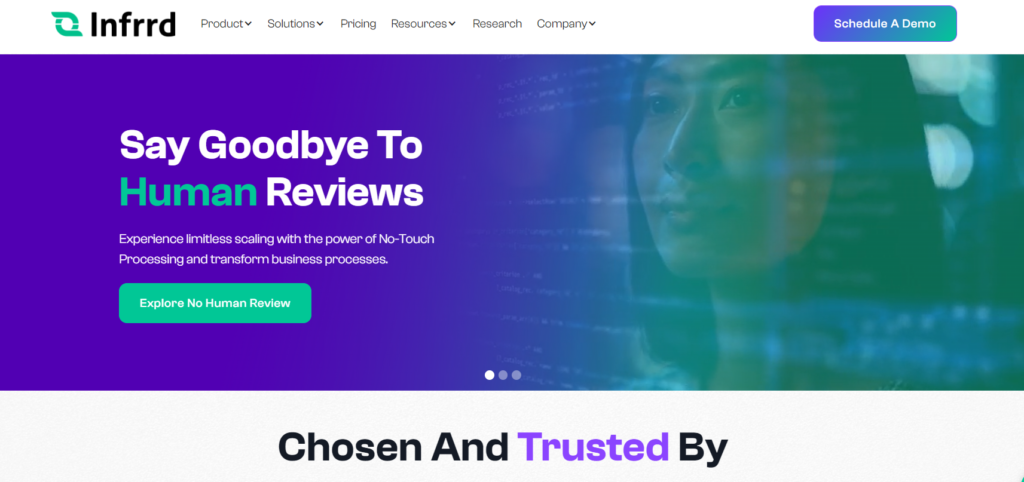
Infrrd’s self-learning capabilities allow it to improve its accuracy with each document processed, reducing the need for manual correction.
| Key Features: | ➡️ AI-powered data extraction for complex documents ➡️ Self-learning models that improve with use ➡️ Specialization in insurance and finance industries ➡️ Customizable workflows to fit specific business needs ➡️ Real-time data analytics for actionable insights |
| Pricing | Infrrd offers custom pricing tailored to the specific needs of the business, volume, and document types |
14. Bright Data
Bright Data, formerly known as Luminati, is a web data extraction tool known for its proxy services. It enables businesses to extract publicly available data from websites without the risk of being blocked.

Bright Data is particularly useful for market research, price monitoring, and competitive analysis, allowing businesses to gather data from global sources efficiently.
15. Docparser
Docparser is a document parsing tool designed for businesses that need to automate the extraction of data from PDFs, scanned documents, and image files.
Docparser allows users to define custom extraction rules, making it highly adaptable to different document formats. It’s a great fit for industries such as logistics, manufacturing, and retail that handle large volumes of paperwork.
16. Nanonets
Nanonets leverages machine learning to automate data extraction from documents, particularly focusing on speed and accuracy.
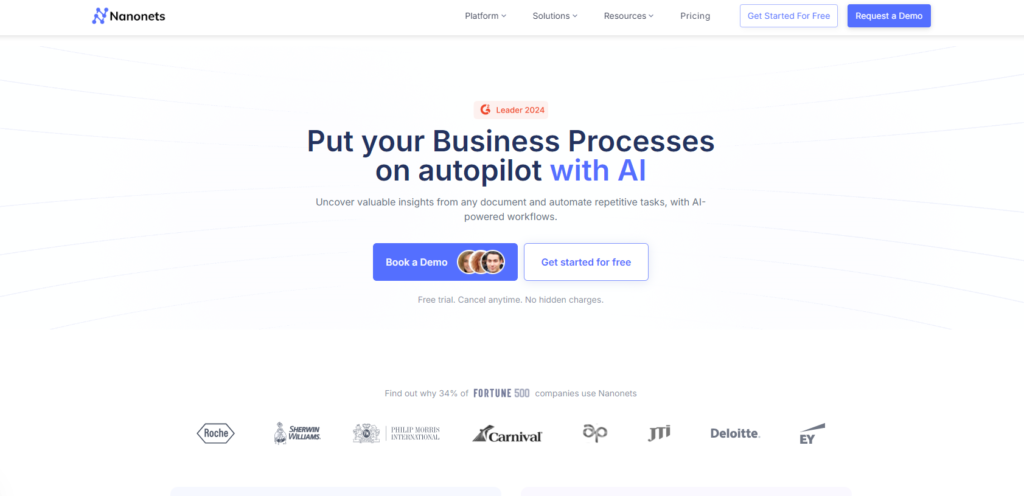
It supports a variety of document types like invoices, receipts, and contracts, making it ideal for businesses in the finance and legal sectors. With an easy-to-use interface, even non-technical teams can create and deploy data extraction models in minutes.
17. Parseur
Parseur is a powerful email parsing tool that allows businesses to extract data from emails, attachments, and PDFs automatically.
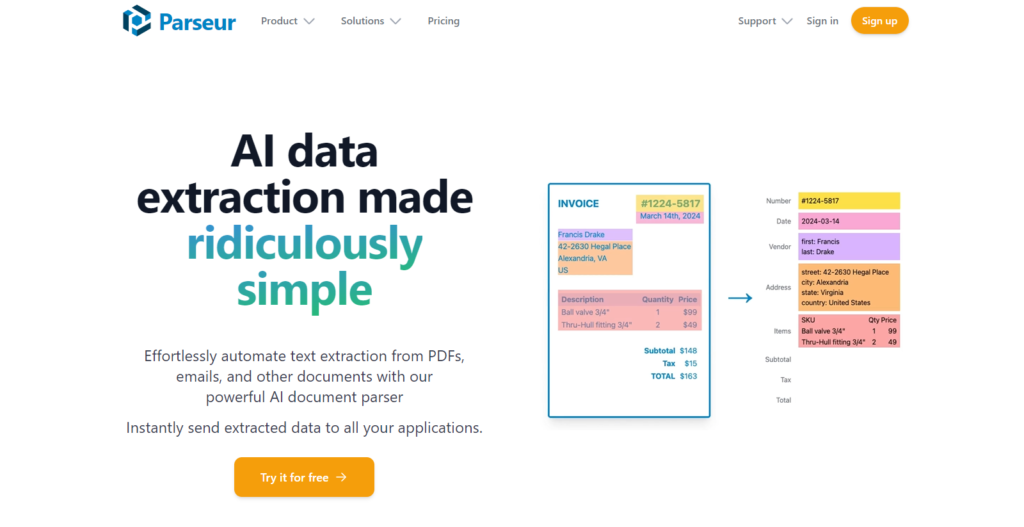
It’s commonly used in industries like real estate, e-commerce, and logistics, where businesses need to process large volumes of customer inquiries, order confirmations, and invoices.
Parseur offers easy integration with popular CRM systems, making it a valuable tool for sales and operations teams.
18. Rossum
Rossum is a cloud-based document processing platform designed to automate data extraction from invoices, receipts, and other transactional documents.
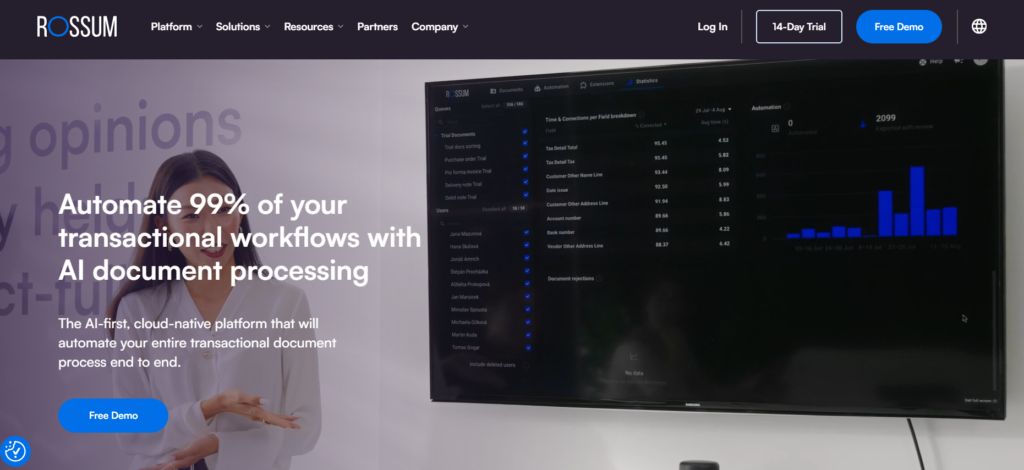
Its AI-powered approach reduces the need for manual data entry and improves the accuracy of financial operations.
Rossum is widely used by finance and accounting teams to streamline invoice processing and reduce errors in financial data.
19. Docsumo
Docsumo is a document AI tool that helps businesses extract data from unstructured documents like invoices, contracts, and ID cards.
It uses AI to classify and extract relevant information, providing a fast and accurate solution for document-heavy industries.
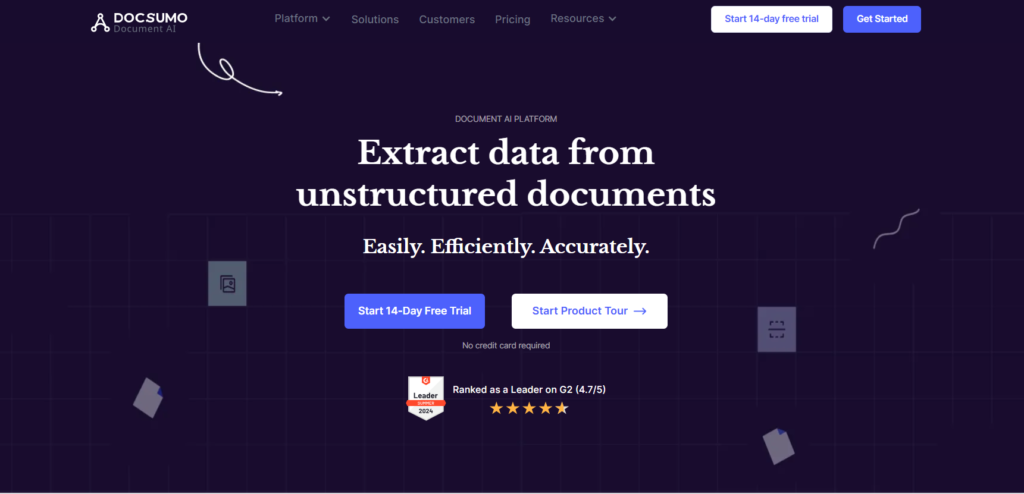
Docsumo is particularly well-suited for finance, logistics, and insurance sectors, where accurate data extraction is critical.
| Key Features: | ➡️ AI-powered data extraction for unstructured documents ➡️ Supports invoices, contracts, and IDs ➡️ Real-time document classification and processingIntegration with accounting and ERP systems ➡️ Custom workflows for specific industry needs |
| Pricing |
20. Matillion
Matillion is a cloud-native ETL platform designed for data extraction, transformation, and loading into cloud data warehouses like AWS, Google BigQuery, and Snowflake.
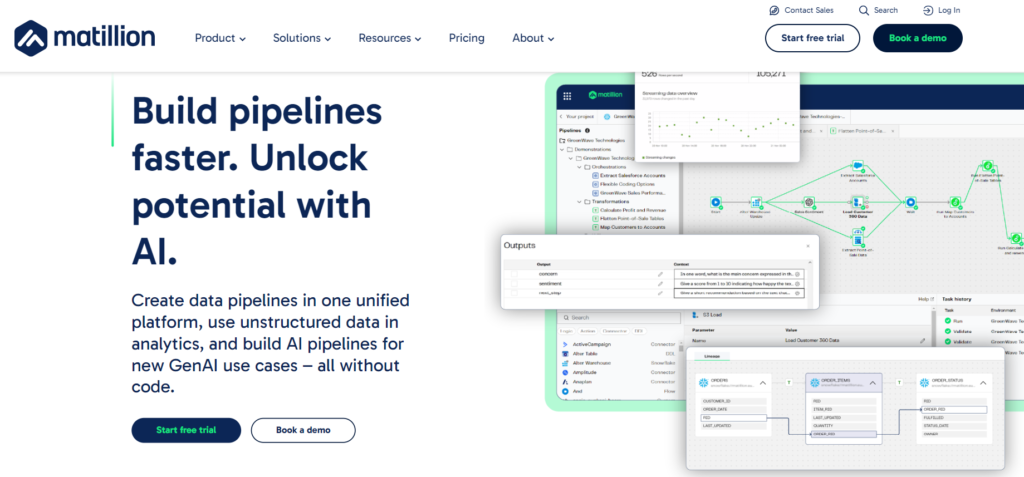
It simplifies the process of moving data from various sources into a centralized location for analytics. Matillion is particularly popular in large enterprises that need to handle complex data pipelines without extensive engineering resources.
Manual vs. Automated Data Extraction: Why Automation is Essential
Manual data extraction is time-consuming, prone to errors, and inefficient when handling large volumes of data. In contrast, automated data extraction tools powered by AI offer speed, accuracy, and scalability.
| Criteria | Manual Data Extraction | Automated Data Extraction |
| Data Accuracy | Prone to errors, especially with large or complex data. | Highly accurate with AI-reducing errors. |
| Processing Speed | Slow, often taking hours or days. | Fast, processing in seconds or minutes. |
| Cost Efficiency | High labor costs make it expensive. | Lower costs after initial setup, no labor expenses. |
| Scalability | Limited by workforce, harder to scale. | Easily scalable without adding workforce. |
| Human Error Risk | High risk of mistakes like typos or misinterpretations. | Minimal human error, more reliable. |
| Compliance and Security | Requires constant monitoring for compliance. | Built-in compliance features ensure data security. |
| Real-time Data Processing | Real-time processing not possible. | Enables real-time data extraction. |
| Customizability | Difficult to adjust to new requirements. | Easily customizable to adapt to changes. |
How to Choose the Right Data Extraction Tool for Your Business
Selecting a data extraction tool for your business requires aligning your specific needs with the tool’s features, scalability, and security. The key is to understand your data requirements and the tool’s functionality before making a decision.
Start by determining the type of data you need to extract and whether real-time processing is critical. Ease of use should also be a priority—especially if your team needs a technical solution or a no-code option.
Following these steps will help you choose a tool that meets your business goals effectively.
Step 1: Identify Your Specific Needs
- Determine if you need to extract structured or unstructured data.
- Assess the volume and frequency of the data to be processed.
- Identify whether real-time processing is necessary for your operations.
Step 2: Evaluate Ease of Use
- Choose between technical and no-code tools based on your team’s capabilities.
- Confirm whether non-technical users can operate the tool if needed.
- Look for drag-and-drop or visual interface options that simplify operations.
Step 3: Check Integration Capabilities
- Ensure the tool is compatible with your CRM, ERP, or cloud storage systems.
- Verify if it offers APIs or built-in connectors for seamless integration.
- Check for compatibility with platforms such as Salesforce, AWS, or Google Sheets.
Step 4: Consider Scalability
- Confirm the tool can manage increasing data volumes as your business grows.
- Make sure it can scale without needing frequent manual interventions.
- Look for performance optimization under high data loads.
Step 5: Analyze Cost and Pricing Structure
- Compare fixed fees against usage-based pricing models.
- Understand how costs will increase as your business expands.
- Take advantage of free trials or demos to evaluate the tool’s value.
Step 6: Prioritize Security and Compliance
- Verify compliance with regulations like GDPR, HIPAA, or industry-specific standards.
- Confirm the presence of data security features such as encryption and audit trails.
- Ensure built-in security measures meet your business’s needs.
Key Considerations for Choosing a Data Extraction Tool:
- Data Volume: Can the tool handle the amount of data you need to process?
- Integration: Does the tool integrate smoothly with your existing systems?
- Customization: Is it adaptable to your specific business needs?
- Accuracy: What is the tool’s error rate for data extraction?
- Budget: How does the cost fit within your financial plan?
By following these steps and considerations, you’ll be well-positioned to select a data extraction tool that supports your business goals while ensuring security, scalability, and integration with your systems.
Conclusion
AI-powered data extraction tools have transformed how companies manage large volumes of data. Automation reduces the time and effort spent on manual tasks, allowing businesses to focus on more strategic activities that drive growth.
By selecting the right tool, businesses can increase accuracy, improve operations, and make better-informed decisions.
KlearStack Automated data extraction, driven by AI, offers a clear path to improved efficiency, accuracy, and compliance. KlearStack, with its advanced features and commitment to innovation, is your partner in this transformation.
Stay ahead with the latest trends and techniques in data extraction.
Book a DEMO Call now to troubleshoot your problems and increase efficiency by 500% while saving 80% on document data entry and auditing costs.
FAQs for Top Data Extraction Tools
-
What are data extraction tools used for?
Data extraction tools automate the process of collecting information from documents, websites, and databases. They help businesses organize and process data quickly and accurately.
-
How do I choose the right data extraction tool for my business?
Consider ease of use, system integration, scalability, security, and cost. Assess your needs, such as real-time processing or handling large data volumes.
-
Are there any free data extraction tools?
Yes, tools like Octoparse and Airbyte offer free plans with limited features, while more advanced options require paid plans.
-
Can data extraction tools integrate with my existing systems?
Most data extraction tools, such as KlearStack, integrate with common platforms like CRMs, ERPs, and cloud services, enabling efficient data transfer and workflow automation.
-
Which is the best data extraction tool?
KlearStack, Docsumo, and Rossum are strong choices for customizable and AI-driven workflows. The best tool depends on your business’s specific use case.


